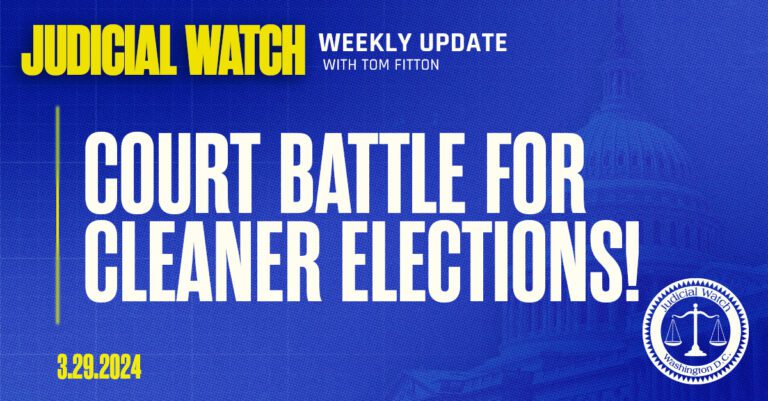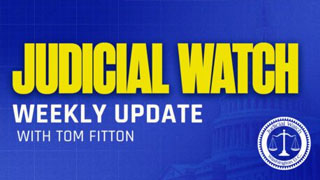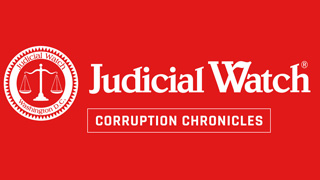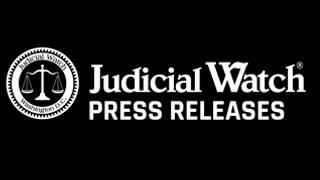

Court Battle for Cleaner Elections!


Judicial Watch Files Supreme Court Brief in Battle to Protect Pregnant Mothers from Abortion Drug
Federal Court Hears Judicial Watch Challenge to Illinois Counting Ballots Fourteen Days after Election Day!
Biden Justice Department Launches Gun Control Resource Center over Weekend to Avoid Scrutiny
Happy Easter!
Judicial Watch Files Supreme Court Brief in Battle to Protect Pregnant Mothers from Abortion Drug
Judicial Watch recently filed an amicus (friend of the court) brief with the United States Court regarding the abortion drug Mifeprex (Mifepristone, formerly known as RU-486).
We argue that “the FDA violated its own unambiguous regulation:”
The judiciary’s default position of bestowing undue deference on federal agencies has led to the rise of an unelected fourth branch of government that touches every aspect of our lives. These federal agencies wield budgets in the hundreds of billions of dollars with little to no oversight….
In 2000, the FDA harnessed the executive power from a political administration with a personal agenda bent on approving the drug mifepristone (“Mifeprex”), which intentionally ends the life of a prenatal human. In approving Mifeprex, the FDA violated its own unambiguous regulation and relied on pretext…. The FDA’s actions in 2016 and 2021 were arbitrary and capricious and violated the Administrative Procedures Act (“APA”).
***
[T]he FDA significantly revised the Mifeprex labeling and REMS [risk evaluation and mitigation strategy] in 2016 and reduced the safety requirements. These changes included significantly altered dosage, removal of the follow-up medical visit, removal of the requirement to take the drug in a doctor’s office, and expansion of the use through 70 days gestation. Also of significance and concern, the FDA modified the REMS to require reporting of only deaths attributable to the drug. No longer would hospitalizations, transfusions, or other serious adverse events need to be reported.
The FDA’s asserted rationalization for these significant changes was that it was “following the science.” The FDA has not, however, provided the science it followed that could reasonably explain the changes.
***
In 2021, using the COVID-19 pandemic as a tool, abortion proponents, led by the American College of Obstetricians and Gynecologists (“ACOG”), sued the FDA to dispense with the REMS in-person medical visit as a prerequisite for obtaining Mifeprex and permit the drug to be mailed.
Through a FOIA lawsuit, we recently uncovered at least six Mifeprex-related deaths between 2000 to 2002 that were detailed in Health and Human Services records.
Make no mistake, this is a dangerous drug. We have known since its inception that the abortion drug Mifeprex is potentially dangerous to the mothers as well as the intended victims, the unborn babies. Extremist abortion politics in the Clinton, Obama and now Biden administration are putting pregnant mothers at risk. Let’s hope the Supreme Court recognizes that an extremist abortion agenda has overcome the rule of law at the FDA.
The Supreme Court heard oral arguments on the abortion pill controversy on March 26.
Records produced to us in September 2023 also included an “Annual Report for Mifepristone,” covering the period September 28, 2000, to September 27, 2001, produced by the Population Council/Danco Laboratories, LLC. The summary indicated that during the testing period 32 “adverse events were reported to Danco and reported by Danco to FDA in periodic reports.” (The existence of adverse event reports does not necessarily establish causation.)
Of the 32 reported adverse events, two were 15-day reports (the others were not serious and/or not unexpected). One of the 15-day reports was reported as “hemorrhage due to a ruptured ectopic pregnancy and death.” [Emphasis added] The other was reported as “post abortal parametritis/endometritis, adult respiratory distress syndrome and bilateral pneumonia.” This latter 15-day report and one case where fever was reported represent the total reports on the marketed drug suggesting infection. In addition, one infection was reported in the Population Council’s 200 mifepristone study and one death [Emphasis added] due to clostridium sordellii infection was reported in the Canadian study.
A post-marketing study dated September 28, 2001, titled “Comparison of abortions induced by mifepristone followed by vaginal versus oral misoprostol up to 56 days gestation,” reported on the “safety results” for 940 women. One person required a blood transfusion, two required administration of intravenous fluids, one required hospitalization, and one died. [Emphasis added] The study reported an overall “success” rate of 97.8 percent.
A September 27, 2002, report on mifepristone indicated that in a study of 971 women administered a combination of mifepristone and misoprostol to induce abortions, one subject needed a blood transfusion, two were administered IV fluids, one was hospitalized, and one died. [Emphasis added]
In an April 19, 2002, “Dear Health Care Provider” letter from Danco Laboratories, in a section titled “New Safety Information,” the company noted:
We have received a small number of reports of ruptured ectopic pregnancies (including one death [Emphasis added] from hemorrhage due to a ruptured ectopic pregnancy). As you will recall, Mifeprex* and misoprostol are not an effective treatment of ectopic pregnancy. Confirmed or suspected ectopic pregnancy is a contraindication for the use of Mifeprex and should be ruled out prior to initiating Mifeprex treatment. Because ectopic pregnancy may be present despite your best efforts to rule it out before starting Mifeprex treatment, you should be mindful of the possibility of an ectopic pregnancy throughout the treatment period and have a plan for its management.
***
Two cases of serious systemic bacterial infection (one fatal) [Emphasis added] following treatment with Mifeprex and misoprostol have been reported.
***
We have also received a report of a myocardial infarction [heart attack] occurring in a 21-year-old woman three days following use of Mifeprex and misoprostol.
A periodic safety update for mifepristone under the brand name Mifegyne that was conducted by Exelgyn Laboratory for the period June 1, 2001, to May 31, 2002, reports:
[T]he Medical Department of Exelgyn recorded from health professionals and authorities 23 spontaneous reports(of which 12 cases of serious adverse events, 11 non serious events and no case from clinical trials) in association with Mifepristone.” [Emphases in original]
The 12 cases of serious events reported during the period of review are classified as follows:
3 serious unlabeled. In which 1 case of unintended pregnancy with fetal malformation, 1 case of death [Emphasis added] and 1 case of thoracic pain (ischaemic accident).
9 serious labeled with 5 cases of unintended pregnancy, 2 cases of allergic reaction, 1 excessive bleeding and 1 septicaemia to Streptococcus.
These revelations came on the heels of an August 16,, 2023, decision by the U.S. Court of Appeals for the Fifth Circuit, in which the Court was asked to consider whether the FDA “overlooked important safety risks in approving mifepristone and amending its restrictions.” The Appeals Court held:
In loosening mifepristone’s safety restrictions, FDA failed to address several important concerns about whether the drug would be safe for the women who use it. It failed to consider the cumulative effect of removing several important safeguards at the same time. It failed to consider whether those “major” and “interrelated” changes might alter the risk profile, such that the agency should continue to mandate reporting of non-fatal adverse events. And it failed to gather evidence that affirmatively showed that mifepristone could be used safely without being prescribed and dispensed in person.
In February 2023, we filed an amicus curiae (friend of the court) brief in support of Texas-based Alliance for Hippocratic Medicine (AHM) in its lawsuit against the FDA over its approval of Mifeprex/Mifepristone. In its brief, Judicial Watch described the FDA’s approval process as “arbitrary, capricious, an abuse of discretion and not in accordance with the law.”
In April 2023, U.S. District Judge Matthew Kacsmaryk in Amarillo, Texas suspended approval of Mifepristone, which essentially made sales of the abortion pill illegal in the United States while the Biden Administration’s legal challenge of the court’s ruling proceeded. Subsequently, the Supreme Court granted emergency requests by the Justice Department and the pill’s manufacturer Danco Laboratories to put the District Court’s suspension order on hold while litigation continues.
In October 2007, we reported on our court victory that forced the FDA to release records about the abortion drug, which included confirmation that the drug was being manufactured in China.
In May 2006, we released a Special Report, containing records that shed light on the Clinton administration’s aggressive drive to push RU-486 to market in the United States. We obtained the documents from the National Archives at the Clinton Presidential Library in Little Rock, Arkansas, in February 2006, shortly after the archives allowed public access to Bill Clinton’s presidential papers.
The Supreme Court is now considering the issue after oral arguments this week. A ruling is expected by June.
Federal Court Hears Judicial Watch Challenge to Illinois Counting Ballots Fourteen Days after Election Day!
Oral argument was held this week in the U.S. Court of Appeals for the Seventh Circuit in the case filed on behalf of Congressman Mike Bost and two other registered Illinois voters to prevent state election officials from extending Election Day for 14 days beyond the date established by federal law (Rep. Michael J. Bost, Laura Pollastrini, and Susan Sweeney v. The Illinois State Board of Elections and Bernadette Matthews (No. 1:22-cv-02754, 23-2644)).
Our lawsuit was filed on May 25, 2022.
In October 2022, Judge John F. Kness rejected a motion by Democratic Party of Illinois to intervene as a defendant in our lawsuit. In July 2023 Kness dismissed the case based upon lack of “standing.” We’re now appealing.
Federal law defines Election Day as the first Tuesday after the first Monday in November of every even-numbered year. The initial complaint states: “Despite Congress’ clear statement regarding a single national Election Day, Illinois has expanded Election Day by extending by 14 days the date for receipt and counting of vote-by-mail ballots.”
We point out to the Appeals Court that Illinois election law allows vote-by-mail ballots received up to 14 days after the polls close on Election Day to be counted as if they were cast and received on or before Election Day. Illinois law also provides that “[e]ven vote-by-mail ballots without postmarks shall be counted if received up to 14 calendar days after Election Day if the ballots are dated on or before Election Day.”
Our brief also notes:
Plaintiffs allege that all ballots received after Election Day pursuant to the Illinois Receipt Deadline are illegal and invalid. These ballots are as invalid as if they were received one year after Election Day, because they violate the federal Election Day statutes. [Emphasis in original]
We argue that holding voting open for 14 days past Election Day violates the constitutional rights of voters and candidates:
Plaintiffs allege three claims. First, they claim Defendants’ receipt and counting of late, illegal ballots dilutes the value of Plaintiffs’ lawfully cast votes, thereby infringing on their right to vote under the First and Fourteenth Amendments … Second, Plaintiffs claim the Receipt Deadline injures them as federal candidates, infringing on their right to stand for office under the First and Fourteenth Amendments … Third, Plaintiffs claim the [14-day extension] violates their federal statutory rights …
We explain:
The Board … advised that the number of ballots received after Election Day through November 17, 2020, could materially affect the unofficial election results.
***
[Illinois’ own data indicates that] Illinois received as many as 266,417 ballots during the period between November 3 (Election Day) and November 17, 2020 (Receipt Deadline) …. This tranche of ballots totaled as much as 4.4% of the total ballots cast in the 2020 election. The record includes unrebutted, contemporaneous statements by Defendants that this tranche could change electoral outcomes after Election Day.
***
By counting untimely and illegal ballots received after Election Day and diluting Plaintiffs’ timely cast and received ballots, Defendants … are depriving Plaintiffs of rights protected under the First Amendment and 14th Amendment” and 42 U.S.C. § 1983.
Judicial Watch also separately just sued Illinois to force the state to clean up its voter rolls, as federal law requires.
Christine Svenson, Esq., of Svenson Law Offices in Palatine, Illinois, is assisting us with the lawsuit.
(We also have a new lawsuit against Mississippi, which like Illinois, also counts ballots that arrive days after Election Day.)
Biden Justice Department Launches Gun Control Resource Center over Weekend to Avoid Scrutiny
The Left knows gun control isn’t popular with the American people so they often try to hide their anti-Second Amendment agenda, as our Corruption Chronicles blog reports.
In an apparent effort to fly under the radar, the Biden administration strategically launched a controversial gun control initiative that is receiving millions of taxpayer dollars on a Saturday instead of a weekday when it is more likely to receive news coverage and social media scrutiny. The program is called National Extreme Risk Protection Order (ERPO) Resource Center and it will train a broad range of the population—law enforcement officials, prosecutors, attorneys, judges, clinicians, social service providers, behavioral health professionals and community organizations—to help keep guns out of the hands of people who pose a threat to themselves or others. It will function under the Department of Justice (DOJ), which has dedicated millions of dollars to get it going. The investment demonstrates the DOJ’s commitment to addressing the gun violence crisis in the United States, according to an agency official quoted in the weekend announcement.
Biden Attorney General Merrick B. Garland claims the multi-million-dollar initiative will provide partners across the country with valuable resources to keep firearms out of the hands of individuals who pose a threat to themselves or others, a key phrase repeatedly used throughout program documents. “The establishment of the Center is the latest example of the Justice Department’s work to use every tool provided by the landmark Bipartisan Safer Communities Act to protect communities from gun violence,” Garland said. ERPO laws are modeled after domestic violence protection orders and create a civil process that allows police, family, medical professionals, and others to petition a court to temporarily prohibit someone at risk of harming themselves or others from purchasing and possessing firearms for the duration of the order. Assistant Attorney General Amy L. Solomon asserts that the nation’s gun “crisis” cannot be solved at one level of government and therefore there must be a collaboration of federal, state, local and holistic solutions to keep American communities safe.
Judicial Watch has filed a Freedom of Information Act (FOIA) request with the DOJ’s Office of Justice Programs (OJP) to uncover records involving the millions in ERPO grants that have been doled out by the agency, including solicitations, requests for proposals, contracts, memoranda, work plans, budgets, purchase orders, meeting minutes, audits and other correspondence. The American public deserves to know what, if any, politically connected entities received taxpayer money to conduct the mission of this questionable gun control program largely crafted in secret. Specifically, Judicial Watch is seeking records for three ERPO grants and the umbrella Biden administration endeavor known as Byrne State Crisis Intervention program that funds the creation and implementation of gun violence reduction initiatives in states around the nation and has distributed over $238 million in the last two years.
An ERPO program called Firearm Crisis Intervention Training and Technical Assistance Initiative has received the largest chunk of money, a total of three awards for $4 million, and Judicial Watch is seeking records that could shed more light on the award process and how the money is spent. The program claims to provide expert guidance, training, and technical assistance to state, local and tribal judges and courts in support of coordinated and effective state crisis intervention court proceedings and related gun violence reduction initiatives. A mystery “advisory committee” provides expertise on assessing and responding to individuals who may pose a risk to themselves or others with a firearm and develops training for court staff and judicial officers regarding firearms laws and best practice as they apply to individuals in crisis. The secret committee also develops and disseminates a “Judicial Toolkit” on firearms and crisis intervention, among other things.
The other two projects funded under the administration’s ERPO initiative and listed in Judicial Watch’s FOIA request are called Implementing Safer Communities Training and Technical Assistance and the John Hopkins ERPO Resource Center (ERC): Maximizing Impact Through Evidence, Equity, and Implementation, which have received $1 million and $2 million respectively. The first aims to advance data collection to help develop and administer tools to ascertain crisis intervention gaps and needs. The second is hub based at a private university in Maryland designed to support states and localities with the implementation of programs to reduce gun violence by providing research, technical assistance and other educational materials.
Happy Easter!
“The great gift of Easter is hope.” – Basil Hume
Christians around the world are celebrating the resurrection of the Christ this Easter. There are no more powerful symbols of hope than the cross and the empty tomb. From me and mine, I wish you and yours all the joy of Easter!
Until next week,















